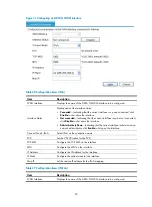
48
Configuring an ADSL/G.SHDSL interface
Overview
The ADSL interface and the G.SHDSL interface support IPoA, IPoEoA, PPPoA, and PPPoEoA.
IPoA
IPoA enables IP packets to traverse an ATM network. In an IPoA implementation, ATM provides the data
link layer for the IP hosts on the same network to communicate with one another, and IP packets must be
adapted in order to traverse the ATM network.
IPoA makes full use of the advantages of ATM, including high speed point-to-point connections, which
help improve the bandwidth performance of an IP network, excellent network performance, and
complete, mature QoS services.
IPoEoA
IPoEoA adopts a three-layer architecture, with IP encapsulation at the uppermost layer, IPoE in the middle,
and IPoEoA at the bottom.
IPoEoA is suitable where Ethernet packets are to be forwarded through an ATM interface. For example,
it works when a network device forwards traffic from an Ethernet across an ATM PVC to a network access
server.
PPPoA
PPPoA enables ATM to carry PPP protocol packets. With PPPoA, PPP packets, in which IP packets or other
protocols' packets can be encapsulated, are encapsulated in ATM cells. In this case, ATM can be simply
viewed as the carrier of PPP packets. As the communication process of PPPoA is managed by PPP, PPPoA
inherits the flexibility and comprehensive applications of PPP.
PPPoEoA
PPPoEoA enables ATM to carry PPPoE protocol packets. With PPPoEoA, Ethernet packets are
encapsulated in ATM cells, through which you can use a PVC to simulate all the functions of Ethernet. To
allow ATM to carry Ethernet frames, the interface management module provides the VE interface. The VE
interface has Ethernet characteristics and can be dynamically created through configuration commands.
The following is the protocol stack adopted by the VE interface:
•
ATM PVC at the bottom layer
•
Ethernet at the link layer
•
Protocols the same as those for a common Ethernet interface at the network layer and upper layers
Configuration procedure
To configure an ADSL/G.SHDSL interface:
1.
Select
Interface Setup
>
WAN Interface Setup
from the navigation tree.
2.
Click the
icon for the ADSL/G.SHDSL interface.
3.
Configure the ADSL/G.SHDSL interface, as described in
.
Summary of Contents for MSR SERIES
Page 17: ...xv Documents 835 Websites 835 Conventions 836 Index 838 ...
Page 20: ...3 Figure 3 Initial page of the Web interface ...
Page 42: ...25 Figure 13 Firefox Web browser setting ...
Page 59: ...42 Figure 27 Checking the basic service configuration ...
Page 73: ...56 Figure 35 Sample interface statistics ...
Page 156: ...139 Figure 139 Rebooting the 3G modem ...
Page 168: ...151 Figure 152 Configuring Web server 2 ...
Page 174: ...157 Figure 158 Configure the URL filtering function ...
Page 242: ...225 Figure 233 Enabling the DHCP client on interface Ethernet 0 1 ...
Page 247: ...230 Figure 236 The page for configuring an advanced IPv4 ACL ...
Page 255: ...238 Figure 241 Advanced limit setting ...
Page 298: ...281 e Click Apply 2 Configure Router B in the same way Router A is configured ...
Page 400: ...383 Figure 387 Verifying the configuration ...
Page 405: ...388 ...
Page 523: ...506 Figure 530 Ping configuration page ...
Page 775: ...758 Figure 785 Configuring a jump node ...






























